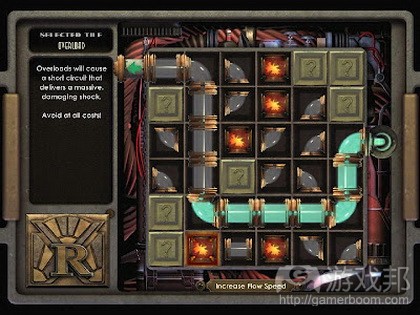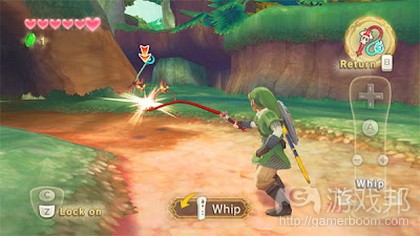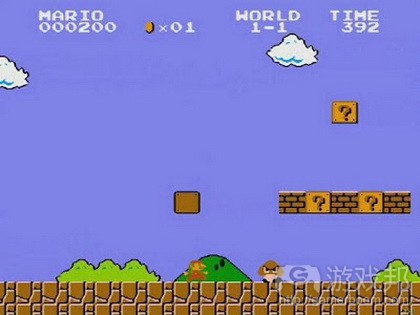现代迷你游戏模式缺乏构思统一性
作者:Eric Schwarz
说到迷你游戏,我们会想到闪烁的按键图标、卡通吉祥物及重复性的操作。多数时候,作为玩家,我们总会看着迷你游戏,抱怨说——虽然它们出于善意目的设计而成,我们总是很快就会产生厌倦情绪,因为我们需要持续重复这些内容。尽管单独体验迷你游戏也许会颇具趣味,但从长远来看它们会带来挫败情绪。
迷你游戏所存在的问题远超乎我们通常认为的重复性。但很多作品已着手将自己的迷你游戏变得更简短、更有趣,认为迷你游戏同整款游戏的设计存在某种联系的普遍看法依然有所欠缺。事实上,迷你游戏要比我们所看到的丰富得多。虽然迷你游戏有其利弊,但它体现一个更深层次的问题——游戏设计的分散化。
什么是迷你游戏?
在谈及游戏设计迷你游戏的影响前,我们首先来看看迷你游戏的构成要素。所有游戏都是由更小的连锁机制构成的,它们最终形成一个玩法系统——若不是出于我们人为设定的若干界限,这些都可以被称作是迷你游戏。《生化奇兵》中的瞄准爆头操作并不比hacking机制更像游戏,但我们依然要清楚区分二者。为什么呢?
有些迷你游戏的划分相当肤浅。在《生化奇兵》中,迷你游戏的划分相当细致,我们很容易就能够辨别出来。玩家启动的玩法序列既不同于标准的第一人称动作玩法,又采用截然不同的控制装置和界面。所有这些都形象说明,“这是个迷你游戏;这不同于标准玩法。”我觉得可能出现这种情况:若这些相同的机制在主要游戏状态中耗尽,很多人就无法看出这一序列属于迷你游戏。因此可以这么说,迷你游戏从某种程度上说是由其表现方式所定义的。
第二,迷你游戏总是存在操作间隔。多数游戏都是由若干重复的循环机制构成,它们会影响自己或其他机制,但迷你游戏将此模式带入新层次(游戏邦注:通过呈现不符既有玩法系统的内容)。无论是诸如《侠盗猎车手IV》保龄球游戏之类的直白迷你游戏,还是像《质量效应2》模式配对之类的抽象内容,它们通常都不会给其他玩法的中心机制和系统带来任何影响——它们最多就是略有触及,如涉及货币机制或友谊评级。
第三,迷你游戏通常非常独立,只有短期衍生效果。这些机制不会持久存在或超越迷你游戏的持续时间——若我们在《阿尔法协议》中打开保险箱,玩家的这一准确举措不会给玩家的总体进程带来任何直接影响。这和其他游戏元素形成鲜明对比,如管理弹药之类的资源——虽然打开保险箱能够给我们带来弹药或资金,但获得这些资源的具体操作属于偶然性质。换而言之,始于迷你游戏的内容最终将在迷你游戏中结束。
所有这些充分说明,迷你游戏并不是由任何内在属性定义,而是根据语境关系。我们倾向将特定模型同迷你游戏绑定,通常是厮杀、撬锁或其他功能,因为多数游戏通常都会以此方式融入这些元素,但之所以存在界限是因为还有内容处于对立位置。尝试进行这样的思维实验:试想若将迷你游戏部分换成“真正”的游戏,游戏会被如何重新定义——若去除表现方式,结果将非常惊人。
打破错误观念
这衍生出一个令人不安的观念——若我们承认迷你游戏就是没有完全移植到既有游戏中的游戏,那么我们从更根本层面把握自己所喜爱的电子游戏意义何在?突然间,构成标准第一人称射击游戏的“30秒趣味性”变得有些肤浅,而完成关卡或完成故事的长期目标变得能够轻松同在线榜单或积分机制相匹敌。我们是否能够将《最终幻想》变成纯粹由系列影片拼凑而成的迷你游戏序列?《光晕》是否只是围绕瞄准目标及管理若干资源抉择,完全和《马里奥聚会》的挑战如出一辙?
这点最典型的表现就是常被忽略的迷你游戏集合。《嘉年华游戏》及前面提到的《马里奥聚会》之类的游戏并没有因此而心生愧疚,但虽然我们经常取笑这些游戏,但其实这些游戏同其他作品的差别并没有那么大,它们其实融入更丰富的机制——它们打破这样的错误观念:它们的玩法标准一致。但玩家通常不愿承认这构成所谓“真的游戏”。
这充分体现在《塞尔达传说》之类的游戏中(游戏邦注:尤其是游戏的最新系列)。虽然游戏有融入主导目标,但在分秒的玩法中,各零星游戏元素除存在美学语境关系外,几乎没有什么联系。利用挂钩从一点荡到另一点和拿剑战斗、掷飞镖或解决砖块移动谜题完全不同。虽然我们通常觉得《Link》(即《Zelda: Links Backyard》)的探险内容更杰出,但它其实并没有那么迷人。当然鲜有《塞尔达》粉丝会承认这点。
虽然如此,但这本身并不是什么问题,开发者也无需因此致歉。很多游戏设计都主要着眼于在其他游戏所创造的框架中完善内容和进行创新,我们因此很容易只是对既有模式做出细微调整,而没有停下来思考游戏真正本质。例如,假设你的任务是制作《侠盗猎车手IV》,你多半不会考虑如何给根本玩法创造强大的机制凝聚力——-你多半是着眼于如何基于玩家已知且喜欢的内容创造出新鲜的有趣情境。这适用于任何游戏序列,甚至包括源自既有题材的新游戏,例如即将问世的地牢探索游戏《Legend of Grimrock》。
划分玩法
事情开始出错,玩家开始有理由抗议的表现是,游戏设计开始出于配合迷你游戏指令的目的而进行调整。现代游戏存在的一个有趣共同之处是,游戏完全基于个人反馈循环及以独立形式存在、只包含随机联系的玩法机制。这几乎存在于所有游戏题材中,而且促使游戏的玩法质量自上代游戏以来就开始走下坡路。
想想《超级马里奥兄弟》。除去怀旧之情,这是款非常有趣的游戏,是设计方面的杰作,但为什么呢?我们通常会以简单但高效的控制装置、杰出的关卡设计及合理的节奏来说明其可行性,但我觉得从更深层次的层面来看,这个问题可以转变成游戏围绕什么机制建立起来。《超级马里奥兄弟》的主题是从怪兽手中救出公主。我们要如何做到?通过穿越陆地,最终达到终点。我们要如何做到?通过克服系列障碍和挑战?我们要如何做到?通过沿路跳跃、躲避和奔跑,最终到达终点。所有问题都有更小的答案,直到我们触及呈现所有这些目标的核心机制。
再来就是《生化奇兵》。什么是游戏的目标?这取决于玩家——是打败Andrew Ryan,还是帮助Atlas,或者是拯救Rapture,抑或是顺利回家?我们要如何实现这些目标?通过由一个关卡移到另一个关卡,直到我们到达设计师嵌入各独立目标的终点。我们要如何实现这些目标?通过不断前进,沿途克服障碍。我们要如何做到?通过探索和获取新能量和新技能,通过模式配对,通过解决谜题,通过射击,通过管理资源等。这有点凌乱,缺乏重点——机制层面,我不清楚《生化危奇兵》究竟要表现什么,而且从故事叙述层面来看,游戏所呈现的内容和玩家完成任务所需进行的操作没有什么直接联系。
《质量效应2》是另一深受此划分模式影响的游戏,在这款游戏中,唯一能够区分各种不同玩法的元素就是视觉包装。实际上,《质量效应2》主要围绕模式配对。你需要进行厮杀和绕道操作,这其实是略有不同的模式配对限时游戏。你需要扫描行星,这虽然没有时间限制,但依然属于模式配对游戏(游戏邦注:这受到玩家耐性的限制)。就连游戏的核心射击操作归结起来也是有时间限制的模式配对游戏,这一操作围绕的是采用剪刀石头布解决方案的健康值/盾牌/盔甲/障碍机制。唯一让人觉得有些独特的机制是,“Firewalker”DLC包裹,这主要关于驾驶气垫船。虽然这些单独来看都非常有趣,但若是通过截图和对话将它们联系起来,它们的联系就显得缺乏意义。
尽管如此,我并不是要将讨论话题转移到游戏的关注焦点。游戏既可以表现单一,也可以涉猎广泛、错综复杂。最重要的是,缺乏提高游戏玩法叙述性的稳固统一主题,游戏就不像是连贯的体验,而更像是系列随机拼凑起来的无意义操作。这就是为什么我觉得包含稳固核心规则的角色扮演游戏,尽管颇为复杂,且规模庞大,依然能够有所侧重,只要设计的各要素能够以有逻辑的连贯方式相互联系起来。制作大型游戏没有什么不妥,但若结合整个体验的粘合剂是系列迷你游戏的框架,那么整款游戏的完整性就会受到破坏。
在我看来,这是现代游戏日渐缺失的元素。电子游戏一直都是受功能和行业竞赛推动,但我强烈觉得如今开发者所角逐的不再是整体游戏内容,而是各种机制包裹,因为游戏的定义不再是基于其呈现给玩家的内容,而是根据较量阶段它们融入的内容数量及单个元素的优化程度。遗憾的是,我所列举的很多游戏(游戏邦注:包括《生化奇兵》、《超级马里奥》、《塞尔达传说》和《质量效应》等)越来越像是迷你游戏集合,而不是单独的电子游戏。
总结
从某种程度上说,迷你游戏趋势并非完全出乎意料。游戏项目逐年日渐扩大,所涉及的人员、资金和时间越来越多。我们很难辨认个人带给游戏的影响,除非是在具体的角色中,缺乏由有远见人士或团队(游戏邦注:他们通常有达成共识)定义的稳固创意方向,我们将很难避开迷你游戏设计的不协调问题。
我想要声明的是,这不是基于怀旧情怀的观点。我对于许多适合迷你游戏模式的新游戏作品的钟情程度不亚于包含稳固、连贯设计的经典游戏。文章也许间接渗透出这样的观点,传统游戏不存在这些问题,或者新游戏作品通常缺乏统一构思,但这并非我的真正意图。简而言之,这不是“X游戏优于Y游戏”的论点。
我觉得这一问题没有简单的解决方案。除非大型游戏项目由单个或少数支配个体控制,否则我们依然会看到许多略显混乱、机制分散的游戏作品。同样,我不认为独立开发者在此能够成为所谓的“救世主”——虽然我很欣赏他们所拥有的创意控制地位,但很多开发者依然也被困于类似的题材和构思中,最终依然还是需要进行相互竞争,争相制作出更大型、更高成本的游戏作品。
这些是开发者在创建游戏机制和系统时需把握的内容,虽然无法做到这些也许并不会带来什么严重损失,但我认为这将带来不错作品和杰出作品之间的差异。我想这就是所谓的“不入虎穴焉得虎子”——若开发者没有积极尝试新鲜的有趣内容,而是反复呈现零散的挑战内容,那么游戏的奖励元素及趣味性将变得日渐趋于平淡。(本文为游戏邦/gamerboom.com编译,拒绝任何不保留版权的转载,如需转载请联系:游戏邦)
Mini-Games and the Compartmentalizing of Design
by Eric Schwarz
When we think of mini-games, we think about flashing button icons, cartoon mascots, and tedious and repetitive actions. Most of the time, we as gamers look at mini-games and groan – while they’re often well-intentioned, we also find ourselves quickly loathing them as we end up having to repeat them over and over. As much as we might enjoy them in isolation, mini-games tend to be a source of frustration over the long haul.
However, the problem with mini-games goes well past beyond the usually-accepted repetition. Whereas many titles have elected to make their mini-games shorter and sweeter, the general understanding of mini-games in relation to game design as a whole tends to be anemic. In truth, mini-games are more than they appear. While they may deserve all the positive and negative sentiments we send their way, mini-games speak to a deeper issue – the compartmentalizing of game design.
What is a Mini-Game?
Before discussing the impact of mini-games on game design, it’s worth taking into account the question of exactly what constitutes a mini-game in the first place. After all, every game is made up of smaller interlocking mechanics which end up forming gameplay systems – and reasonably, all of those could be called mini-games if not for some artificial boundaries we have set. Lining up headshots in BioShock isn’t necessarily any more a game than its hacking mechanic, yet we draw the line very clearly all the same. Why is this?
Part of the distinction is entirely cosmetic. In BioShock’s case, the mini-game is compartmentalized to a degree that makes it easy to identify. The player initiates a gameplay sequence so divorced from the standard first-person action gameplay, right down to completely different controls and interface (i.e. 2D vs. 3D). Everything about this visually says “this is a mini-game; this is separate from the standard gameplay.” I find it likely that, if these same mechanics played out in the main game state, many people would have trouble referring to such a sequence as a mini-game. Thus, it’s fair to say that mini-games are at least to a degree defined by presentation.
Second, there is usually a mechanical distance in a mini-game. Most games consist of some form of repetitive, cyclical mechanic which informs and influences either itself or other mechanics (i.e. output state going directly back into input, such as a shooter’s “pick up ammo; spend ammo; pick up ammo” loop), but a mini-game tends to take this to a whole other level by providing something that simply doesn’t mesh with the existing gameplay systems. Whether it’s a literal mini-game like Grand Theft Auto IV’s bowling, or an abstract one like Mass Effect 2′s pattern-matching, there really is nothing about playing them that directly influences the central mechanics and systems within the rest of the gameplay – links are tangential at best, like feeding into a currency system or a friendship rating.
Third, mini-games tend to be self-contained and have short-term ramifications. The mechanics do not persist or go beyond the mini-game’s duration – when we crack a safe in Alpha Protocol, the precise actions the player takes don’t have much if any bearing on the player’s overall progress in any direct way. This is in stark contrast to other game elements, like management of resources such as ammunition – even if getting that safe open provides us with ammo or money, the details in the acquisition of those resources are basically incidental. What starts in the mini-game ends in the mini-game, in other words.
All of this adds up to suggest that mini-games are, at their root, defined not by any inherent properties, but by context. We tend to attach certain archetypes to mini-games, usually hacking, lockpicking and other functions, because most titles commonly incorporate them this way, but the boundaries only exist because there is something else that stands in opposition. As a fun thought experiment, try to think about how certain games can be redefined simply by changing the proportions of mini-game to “real” game – the results might be surprising when the presentation itself is stripped away.
Breaking the Illusion
Of course, from this realization comes a somewhat disturbing thought – if we allow that mini-games, are, at their core, basically just games that aren’t fully fleshed out grafted onto existing games, what does this say about our understanding of our favorite videogames on a more fundamental level? Suddenly, those “30 seconds of fun” that make up your standard first-person shooter start to seem just a little bit more shallow, and the long-term goal of completing a level or finishing the story can be just as easily compared to an online leaderboard or a score mechanic. Could Final Fantasy really be nothing more than a sequence of mini-games held together by a series of cinematics? Is Halo really just about pointing while managing a few choice resources (time, ammo, health), no different from a Mario Party challenge?
The height of this can, of course, be seen in the oft-derided mini-game collections. Titles like Carnival Games and the aforementioned Mario Party make no apologies for what they are, but as much as we tend to poke fun at this sort of game (or package of games), the fact remains that these types of games aren’t all that much different from most others, and in fact often have far more mechanical variety – they’ve just dropped the pretense, the illusion that they are some grand unified symphony of gameplay. Yet gamers tend to refuse to accept that such a thing constitutes a “real game.”
This is best exemplified in a game like The Legend of Zelda, especially the newer titles. Although the games do feature overarching goals (beat Ganon, collect all the Heart Containers, etc.), in minute-to-minute gameplay there often isn’t much to link the different bits and pieces together beyond the aesthetic context. Using the grappling hook to swing from point to point isn’t too similar to fighting with a sword, or throwing the boomerang, or solving a block-pushing puzzle. As much as we like to think of Link’s adventures as grand and epic tales, the truth is, practically speaking, a lot less glamorous. Of course, finding a Zelda fan who would admit to this is probably going to be a challenge.
Granted, this isn’t really a problem in itself, or something to apologize for. So much of game design is so heavily focused on improving and innovating within the frameworks created by other games, it’s easy to get caught up in making minor changes to established formulas without necessarily stopping to think about what a game really is. If your job is to make, for example, Grand Theft Auto IV, chances are you’re not going to be thinking about how to create strong mechanical cohesion on any fundamental level of gameplay – you’re thinking about how to provide players with new and exciting scenarios that build upon what they already know and love. This is true for just about any sequel and even for new games within established genres, like the upcoming dungeon crawler Legend of Grimrock.
Compartmentalizing Gameplay
Where things start to go awry, and where I think the protests of gamers begin to make more sense, is when game design begins to change in order to service the mini-game mandate. Increasingly common in modern games is the creation of a game almost entirely around individual feedback loops and mechanics which exist in isolation and are linked only in the most incidental of ways. This is common across virtually all genres and has, in my opinion, led to a general degradation in the quality of gameplay over the last generation of gaming.
Consider Super Mario Bros. Nostalgia aside, it’s a fantastic game, and a masterwork of design, but why? We often point to simple but effective controls, brilliant level design, and good pacing as examples of why it works, but I think on a deeper level the question can be answered by examining what the game mechanics are built around and for. Super Mario Bros., at the end of the day, is about rescuing a princess from the clutches of a monster. How do we do that? By traveling across the land to reach the final stage. How do we do that? By overcoming a number of obstacles and challenges? How do we do that? By jumping, dodging and running our way to the end. Each question has a smaller answer, until we reach the central mechanic that fuels all of these goals.
Now, take BioShock. What’s our goal? Well, that depends on the player – is it to defeat Andrew Ryan, or help Atlas, or save Rapture, or get back home? How do we do that? By moving from level to level until we reach whatever end point the designer has decided encapsulates all these disparate goals. How do we do that? By walking along and overcoming obstacles on the way. How do we do that? By exploring and acquiring new powers and abilities, by pattern-matching, by puzzle-solving, by shooting, by managing resources, etc. It all gets just a little bit messy and unfocused – mechanically, I’m really not sure what BioShock is supposed to be about, and narratively there isn’t a direct relationship between what’s going on and what the player has to do to accomplish that task.
Mass Effect 2 is another game that ends up being heavily impacted by this compartmentalization, to the point where practically the only thing differentiating different pieces of gameplay is the visual packaging. Effectively, Mass Effect 2 is about pattern-matching. You’ve got hacking and bypassing, which are mildly different pattern-matching time-limited games. You’ve got planet-scanning, which while not time-limited, is still a pattern-matching game (and arguably limited by the player’s patience). Even the game’s core shooting, revolving around health/shield/armor/barrier mechanics with rock-paper-scissors solutions, effectively boils down to time-limited pattern-matching. The only game mechanic that feels truly separate comes in the game’s “Firewalker” DLC pack, which involves piloting a hovercraft. While these are all fun in isolation, baked together as they are through cutscenes and conversations, they don’t build on each other in any meaningful ways.
Granted, I don’t mean to turn this into an argument about game focus. Games can be singular, or they can be large and involved and huge. The key point to take away is that without a strong unifying theme that helps drive things ludonarratively, a game begins to feel less like a coherent experience and more like a series of relatively arbitrary actions divorced of greater meaning. This is why I’d argue a role-playing game with a strong core ruleset that influences all aspects of the game, despite being extremely complex and large, can still be very focused so long as each aspect of the design informs the other in a logical and consistent way. There’s nothing wrong with making a large game (or one with mini-games for that matter), but when the glue holding the experience together is a frame for a series of mini-games, the integrity of the complete game begins to suffer.
That, to me, is what many modern games have started to lose. Videogames have always been driven by bullet points, features, and industry competition, but more than ever I think the bar has been raised to the point where developers are competing not in terms of games as a whole, but games as literal packages of mechanics, as products that aren’t defined by what experience they offer the player but by how many things they include next to the competition, and how well-polished each of those individual things are. The unfortunate truth is that many of the examples I’ve provided – BioShock, Super Mario, The Legend of Zelda, Mass Effect, etc. – are all beginning to resemble the mini-game collections more than single videogames.
Closing Thoughts
This mini-game trend isn’t really surprising, in a way. Game projects are getting bigger and bigger with every year, with more people working on them and more money and time being spent. The individual impact of a single person on a game is becoming very difficult to spot except for in very specific roles (such as writer), and without a strong creative direction defined by a prescient individual or a group of people that are all on the same page, I don’t think the mini-game design dissonance is something that can be easily avoided.
I want to stress that this isn’t an argument from nostalgia. I love a lot of new games that fit the mini-game model, just as I love classic games that feature a tight, unified design. Indeed, I’ve perhaps inadvertently drawn a line in this article that suggests that older titles weren’t susceptible to these same issues, or that new games can’t feature a single defining mindset – which is also something I don’t necessarily mean to insinuate. Summarily, this isn’t an “X games are better than Y games” argument either.
I don’t think there is an easy solution to this problem. Unless larger game projects all manage to end up governed by a single or very few controlling individuals, we’re still going to get lots of games that feel discombobulated and mechanically compartmentalized. Similarly, I don’t think indie developers are necessarily the saviours some consider them to be – as much as I appreciate the creative control afforded to indies, many also find them locked into the same familiar genres, concepts and ultimately still have to compete with each other and with bigger, more expensive games.
Ultimately, it’s something that designers simply need to be aware of and understand in creating the mechanics and systems that move a game forward, and while the consequences of failing to do so might not be disastrous, in my opinion they can mean the difference between a good game and a great game. I think the old saying “nothing ventured, nothing gained” applies – if players aren’t tested in new and interesting ways, but rather simply replay the same segmented challenges again and again, the rewards, and fun, are bound to grow stale.(Source:gamasutra)










































 闽公网安备35020302001549号
闽公网安备35020302001549号